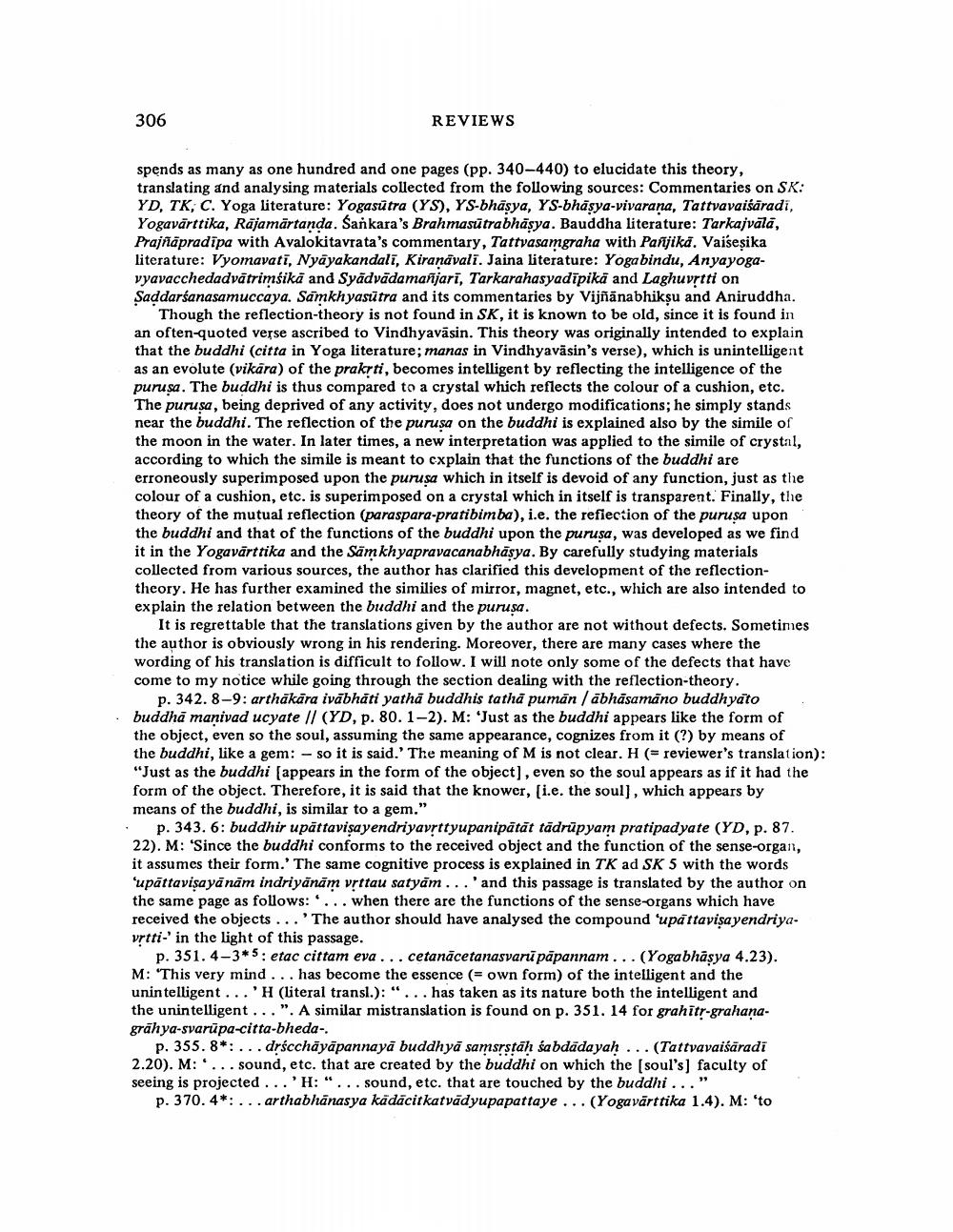________________
306
REVIEWS
spends as many as one hundred and one pages (pp. 340-440) to elucidate this theory, translating and analysing materials collected from the following sources: Commentaries on SK: YD, TK, C. Yoga literature: Yogasutra (YS), YS-bhasya, YS-bhasya-vivarana, Tattvavaiśāradi, Yogavārttika, Rājamārtanda. Sankara's Brahmasūtrabhāsya. Bauddha literature: Tarkajvala, Prajñāpradīpa with Avalokitavrata's commentary, Tattvasamgraha with Panjikā. Vaisesika literature: Vyomavati, Nyāyakandalī, Kiranävali. Jaina literature: Yoga bindu, Anyayogavyavacchedadvātrimśika and Syādvādamañjari, Tarkarahasyadīpika and Laghuvrtti on Saddarśanasamuccaya. Samkhyasūtra and its commentaries by Vijñānabhikṣu and Aniruddha.
Though the reflection-theory is not found in SK, it is known to be old, since it is found in an often-quoted verse ascribed to Vindhyavāsin. This theory was originally intended to explain that the buddhi (citta in Yoga literature; manas in Vindhyavāsin's verse), which is unintelligent as an evolute (vikara) of the prakrti, becomes intelligent by reflecting the intelligence of the purusa. The buddhi is thus compared to a crystal which reflects the colour of a cushion, etc. The purusa, being deprived of any activity, does not undergo modifications; he simply stands near the buddhi. The reflection of the purusa on the buddhi is explained also by the simile of the moon in the water. In later times, a new interpretation was applied to the simile of crystal, according to which the simile is meant to cxplain that the functions of the buddhi are erroneously superimposed upon the purusa which in itself is devoid of any function, just as the colour of a cushion, etc. is superimposed on a crystal which in itself is transparent. Finally, the theory of the mutual reflection (paraspara-pratibimba), i.e. the reflection of the purusa upon the buddhi and that of the functions of the buddhi upon the purusa , was developed as we find it in the Yogavārttika and the Samkhyapravacanabhāsya. By carefully studying materials collected from various sources, the author has clarified this development of the reflectiontheory. He has further examined the similies of mirror, magnet, etc., which are also intended to explain the relation between the buddhi and the purusa.
It is regrettable that the translations given by the author are not without defects. Sometimes the author is obviously wrong in his rendering. Moreover, there are many cases where the wording of his translation is difficult to follow. I will note only some of the defects that have come to my notice while going through the section dealing with the reflection-theory.
p. 342.8-9: arthākāra ivābhāti yathā buddhis tathā pumān / ābhāsamano buddhyato buddhā manivad ucyate // (YD, p. 80.1-2). M: 'Just as the buddhi appears like the form of the object, even so the soul, assuming the same appearance, cognizes from it (?) by means of the buddhi, like a gem: - so it is said.' The meaning of M is not clear. H (= reviewer's translation): "Just as the buddhi (appears in the form of the object), even so the soul appears as if it had the form of the object. Therefore, it is said that the knower, [i.e. the soul), which appears by means of the buddhi, is similar to a gem." . p. 343. 6: buddhir upăttavisa yendriyavrttyupanipätāt tādrupyam pratipadyate (YD, p. 87. 22). M: 'Since the buddhi conforms to the received object and the function of the sense-organ, it assumes their form. The same cognitive process is explained in TK ad SK 5 with the words 'upāttavisayā nām indriyānām vrttau satyām...' and this passage is translated by the author on the same page as follows:'... when there are the functions of the sense-organs which have received the objects ... The author should have analysed the compound 'upă ttavisayendriyavrtti-' in the light of this passage.
p. 351.4-3*5: etac cittam eva ... cetanācetanasvaru pāpannam ... (Yogabhāşya 4.23). M: 'This very mind ... has become the essence (= own form) of the intelligent and the unintelligent...'H (literal transl.): "... has taken as its nature both the intelligent and the unintelligent ...". A similar mistranslation is found on p. 351. 14 for grahit-grahanagrāhya-svarūpa-citta-bheda-.
p. 355.8*: ... drścchāyāpannayā buddhyā samsrstāh śabdāda yah ... (Tattvavaišaradi 2.20). M:... sound, etc. that are created by the buddhi on which the (soul's] faculty of seeing is projected ...'H: "... sound, etc. that are touched by the buddhi ..."
p. 370.4*: ... arthabhānasya kādācitkatvadyupapattaye ... (Yogavärttika 1.4). M: 'to




